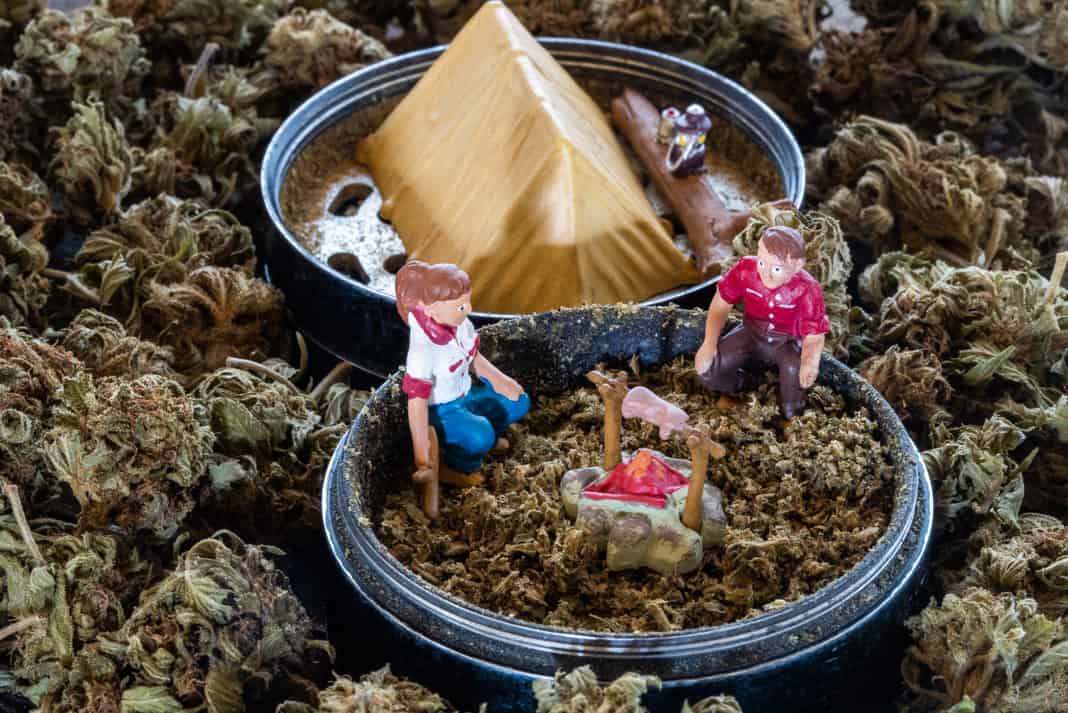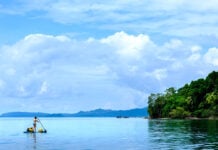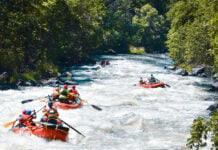Picture this. A luxury guided trip. Ultralight canoes. Six-inch-thick air mattresses. Pan-seared steaks prepared over the fire at night. Chocolate fondue drizzled over fresh fruit for dessert. A friendly guide offering you the choice between a pinot noir and a cabernet sauvignon. All set under the backdrop of hanging boughs in a remote, spruce forest. Sounds a bit like paradise.
Now can you imagine the same scene, but instead of offering wine, your friendly guide offers up some cannabis?
That’s exactly what some new start-ups are proposing to do this summer. Thanks to legalization in October of 2018, Canada’s cannabis business is booming. Canadians are slated to spend $4.3 billion on cannabis sales in 2019, according to Deloitte, and that’s said to be just the tip of the iceberg. With experiential tourism continuing to be the hottest niche in travel, experts are predicting cannabis tourism to be Canada’s next high.

South of the border, in states where weed is legal, tourists can seek out thriving bud and breakfasts, puff-and-paint classes, blaze-and-gaze art tours, weed-infused yoga classes, cannabis-friendly wellness spas and blossoming coffee shop scenes. Think of every activity tour operators have ever paired with wine or beer tastings—cycling, gourmet food, walking tours, and more—and imagine it with marijuana.
As Canada’s first summer with legal cannabis approaches, a handful of entrepreneurs are taking reefer madness to new heights, pairing cannabis’ new legal status with the most classic of Canadian pastimes—camping and canoeing.
New Green Economy
“Canoeing is quintessentially Canadian, and there is going to be an increase in tourism for cannabis—we’re trying to be ahead of the game,” says Jeremy Blair, owner of Ontario Cannabis Tour (OCT) (ontariocannabistour.ca). The company specializes in fully-guided, cannabis-infused backcountry canoe trips in Algonquin Provincial Park and on the class I to III Madawaska River. It starts running trips this summer.
OCT is a BYOB operation—bring your own bud. “Due to the regulations, we can’t purchase cannabis for clients, but we can make recommendations on strains based on desired effects,” says Blair.
Once clients arrive, OCT runs like any other full-service guided trip. Trips start at $550 for a long weekend, and include equipment, transport, food—some of it cannabis-infused—as well as three guides who are experienced with cannabis. Of those three guides, one acts as a cannabis guide—like a sommelier but with more plaid and marijuana—while the others remain sober for risk management purposes.
Blair anticipates a majority of this summer’s clients to arrive internationally, but he’s also getting interest locally from seniors attracted by the pain relief potential of cannabis, in addition to the full-service guiding.
“There’s a consumer out there looking for a more in-depth experience with cannabis and a lot of people who are curious first-time users. Either way, this is a safe space to explore,” he says. Blair is quick to agree with comparisons to alcohol—is what OCT offers different than luxury guided tours providing their clients with a glass of wine or a beer after a day of paddling? Is it much different than guided canoe trips touring the distilleries of Scotland by paddle?
“Of course, we’ve also seen what alcohol can do. You can enjoy yourself with a couple of beers, or you can be the drunken fools. We’re providing an opportunity to experience cannabis responsibly,” he says.
We view cannabis as an addition to the camp routine only
On any Canadian canoe trip, guided or not, cannabis can only be consumed off the water and canoeists cannot be on the water intoxicated. Toking up in a canoe could result in a $1,000 to $5,000 fine. A landmark decision last fall declared canoes subject to the Criminal Code of Canada’s impaired driving laws. The first case in Canadian history where a paddler has been charged with impaired operation of a vessel causing death is currently before courts.
“We view cannabis as an addition to the camp routine only,” says Blair, stressing that consumption only happens after the paddling day is done.
Spliffs And S’mores
Under Canada’s new laws, adults can carry 30 grams of cannabis—almost enough loose buds to fill a one-liter Nalgene—on domestic flights, in cars and, yes, in canoes, so long as the cannabis is stored and sealed. However, where it can be consumed varies by province, with some provinces treating it like alcohol and others treating it more like cigarettes.
Last fall, Parks Canada announced it would allow cannabis use at its campsites. “While Parks Canada campgrounds are public areas, the agency treats individual campsites as temporary domiciles for our visitors. For this reason, at Parks Canada campgrounds, consumption of cannabis will be permitted in campsites,” spokesperson Marie-Hélène Brisson wrote in an email to the CBC, likening its rules to those around alcohol.
However, she cautioned: “It is important to maintain environmental awareness and a clear mind when performing activities in Parks Canada’s places to help prevent accidents, incidents or injury.”
The warning is an understatement to some. Not everyone is stoked on the idea of legal cannabis entering the outdoor recreation sphere. In an article titled “Why it’s a Bad Idea to Get High in the Mountains,” posted last summer on British Columbia’s North Shore Rescue (NSR) blog, first responder Curtis Jones writes, “There is no safe way to experiment with drugs in the mountains… The combination of mind-altering drugs and being in the wilderness is a terrible and dangerous idea.”
The mountains are not the place to lose yourself in a drug-induced stupor
In response to impending legalization and the burgeoning canna-tourism scene, he wrote that SAR teams have enough trouble with unprepared hikers flocking to the mountains and regularly respond to calls for those who are well prepared, do everything right, are completely sober, and still get into trouble. “Being in the mountains is worthwhile, but it comes with significant risks, which can be reduced through fitness—including being clear-headed—and preparation,” he says. “When you’re high in the mountains—and I don’t mean elevation—you shift your position on the continuum between prepared hiker and candidate for rescue significantly towards the latter position.”
Jones goes on to cite recent intoxication-related incidents North Shore Rescue responded to, including a snowshoer who consumed edible marijuana, had a seizure and required intubation and ventilation; a hiker who consumed mushrooms and marijuana, and fell 60 meters into a ravine sustaining a serious head injury; and two young people who left a bar on Burnaby Mountain drunk, took a shortcut down the mountain and fell to their deaths.
“The mountains are not the place to lose yourself in a drug-induced stupor, nor are they a place to experiment and learn your tolerance. The reality we face is the wilderness is unforgiving, and it can take a long time for rescue crews to reach you, even if you are only a couple of kilometers up the trail,” Jones writes. “This is our plea to everyone to be responsible in the mountains, and leave the weed at home.”
There are high-profile stories confirming these fears—a highly publicized case in 2017 of four men getting stoned on Scafell Pike, England’s tallest peak at 3,100 feet, and rallying a mountain rescue with air support and ambulance to get them off the summit comes to mind. However, statistics on the effect legal cannabis has had on search and rescue operations are hard to find. So Paddling Magazine contacted four search and rescue organizations in the outdoor recreation mecca of Colorado, the first state to legalize cannabis five years ago. Colorado now hosts millions of cannabis tourists on weedcations every year and credits a quarter of its tourism to legal cannabis.
“We have not noticed any uptick in search and rescue mission counts or incident type trending that can be related to recreational marijuana use,” says Patrick Caulfield, commander of Fremont Search and Rescue, located a few hours south of the mile-high city, Denver. He adds drug-related SAR activities in Fremont are rare.
“The biggest challenges currently for the SAR community are the increasing number of people getting out there, social media-based versus experience-based expectations of a backcountry adventure, and inadvertent non-emergency activation of personal locator beacons,” he says. “All result in an increasing number of missions for our non-paid professional SAR teams here in Colorado.”
Cannabis And Canoe Culture
Recreational marijuana use is currently legal in Colorado, Alaska, Washington, California, Nevada, Oregon, Maine, Vermont and Massachusetts. Another 22 states are pursuing some form of cannabis decriminalization or legalization. And while the cannabis tourism industry flourishes in some states, outdoor recreation within it remains a small niche.
“A lot of cannabis tourism in the U.S. focuses on immersing cannabis in party-style tours. I see an opportunity in Canada to get away from that, and more into education and sightseeing opportunities,” says Tristan Slade, owner of Vancouver-based High Definition Tours (highdefinitiontours.com) and a founding member of the National Association of Cannabis Tourism (NACT). “The goal is to combine Canadian culture and cannabis culture in a fun and legal environment.”
Many cannabis strains are complementary to physical activity
Matt Cronin, founder of Canada High Tours (www.canadahightours.com), provider of more than two dozen cannabis-infused experiences, expects growth to be slow but steady. “Alberta is ahead of the curve in terms of instant access to legal dispensaries. Coupled with their amazing parks and lakes, we believe Alberta will be the go-to province for combining all that’s great about Canadian and cannabis culture, especially when we look at outdoor activities—kayaking, hiking and camping.”
Slade is quick to note the risk factors many outdoor recreation activities present aren’t compatible with any level of intoxication and indicates cannabis should be consumed back at camp or after activity has concluded.
But not everyone agrees. “Many cannabis strains are complementary to physical activity,” Cronin insists. “And equally, just like you may have a beer or two after a long hike or a two-hour paddle, you may well want to sit back, relax and have a nice mellow joint or two instead.”
Cronin’s clients are diverse—from 20 to 60 years old, and from Canada, the U.S. and Europe. In addition to the Maligne Lake Paddle and Puff Experience (two hours, $95) which takes place in Jasper National Park, Canada High Tours offers a Stoned Stampede Experience—which is a visit to the Calgary Stampede—and a Moose and Mashed Experience—a wildlife viewing opportunity—plus more typical fare appealing to the average canna-curious tourist. It’s this type of tour—low commitment, half-day trips with less risk and investment than a backcountry-style tour—that have gained a foothold in the U.S.
NACT’s Slade is quick to note stigma is a barrier for the emerging market, both in terms of attracting new customers, but also in reticence from owners of already established tourism operations to experiment.
Black Feather, a Canadian guiding company with 30 years of experience leading remote paddling trips all over Canada, has no plans to welcome cannabis on trips, according to lead guide Steve Ruskay.
“The spirit of our policy remains the same,” he says. “No one—guide or guest—shall consume any substance that causes impairment before or during any wilderness activity. On certain trips in high-risk environments, no consumption is permitted at all.”
Ruskay adds there’s not enough evidence to determine to what extent, and for what duration, impairment from cannabis will cause, and therefore guides are not to permitted to consume cannabis while in the field. Alcohol consumption for guides is also limited to certain trips, small amounts, and after all activity has concluded. Similarly, Paddle Canada’s policy extends to any inhibitors of judgement, “so even though it was written pre-cannabis legalization, we didn’t feel a need to update it,” says executive director Graham Ketcheson. Paddle Canada members may not consume alcohol, cannabis or other drugs on the water, and there must be eight hours between consumption and paddling. “This is a safety policy for Paddle Canada instructors and for participants taking training, to make sure all are coherent and able of mind and body,” adds Ketcheson.
The risks can’t be ignored, but nor can the fact Canada’s cannabis-tourism industry is about to spark. Mixing weed and wilderness legally has only just begun and integrating cannabis into Canadian experiences—whether city tours, tastings, wellness experiences or backcountry campfires—is already in full swing. It’s something the entire outdoor community will have to reckon with. Regardless of the controversy, pot-loving adventurers, tourists and entrepreneurs will be enjoying Canada’s green rush and blazing new trails this summer, legally for the first time.
Kaydi Pyette is the editor of Paddling Magazine. Of the more than 40 slang names for cannabis she came across while writing this article, her favorite was the wacky asparagus.
Cannabis + Campouts + ??? = Profit! As Canadians smoke, eat and otherwise consume $4 billion in cannabis products in 2019, marijuana tourism of all kinds is predicted to drift into a campground near you. Feature Photo: Colin Field









I’ve been paddling for almost five decades. Alcohol abuse by people using canoeing as a vehicle for public intoxication with little fear of jeopardy has already given the sport a bad name. A prime example is the Current River in Missouri. On any given summer or holiday weekend, the river is bow-to-stern with canoes full of people whose primary goal is to get drunk, act stupid, make noise, and disturb what otherwise could have been a beautiful float on a scenic river. Don’t believe me? Try doing a trip there and you’ll see what I mean. Virtually any river that has a canoe livery experiences a similar thing. Folks who own property on or near these rivers look upon canoeists with disdain for much the same reasons as some folks think every motorcyclist is a Hell’s Angel. Now we’re looking at adding pot smokers to the mix. I’m not here to debate the legality or morality of pot, or it’s potential tax revenues. I used to smoke it myself. However, this new trend will allow wilderness waterways to be invaded by people who aren’t looking to experience wilderness, but are instead looking for a new place to catch a buzz. It will become more pervasive than the alcohol problem because pot doesn’t weigh much and can easily be portaged into backcountry areas where lugging a case of beer or a bottle of whiskey adds too much weight to be practical. These potential “outfitters” are merely looking at using a new trend to make money with little regard to the negative consequences. I think that offering guided trips with pot is a mistake. It sends the wrong message about canoeing, and it spoils the wilderness experience for those seeking nature in its natural state – and not in an altered state.